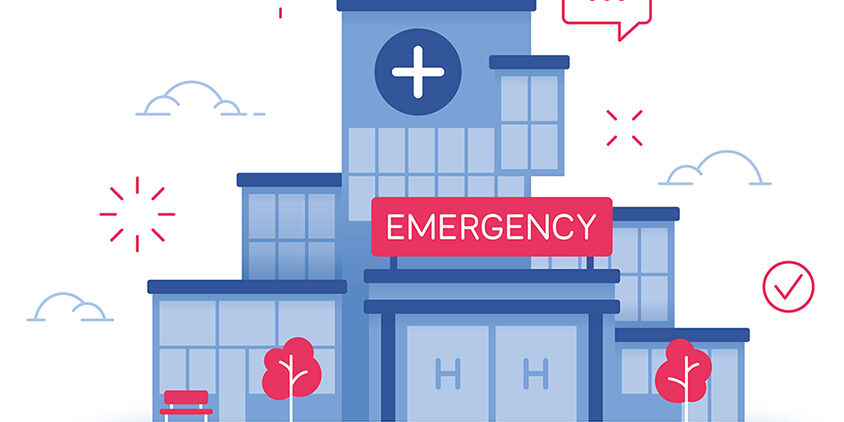
Smart Steps to Take in a Medical Emergency
By Darlene Demetri | Tuesday, August 8, 2023
5 Second Summary
When you live with a rare disease, it’s important to know what you need to prepare, do, and say when you’re confronted with a medical emergency, whether that involves an ambulance or a hospital.
Sometimes, Crystal Killian, who lives with mitochondrial myopathy (MM), suddenly runs out of energy. When she experiences a severe “mito crash,” her nerves and muscles don’t work, her coordination is off, and she’s unable to communicate. Going to the emergency room (ER) in this state puts her in a difficult position because the symptoms look a lot like a stroke, but stroke medications won’t help her — they’ll cause serious complications.
The first responders and ER nurses and physicians who treat Crystal are in a difficult position, too. They generally haven’t had any training on mitochondrial myopathy and may have never encountered a patient with this rare neuromuscular disease. They’re trying to provide the best care they can; they want to help, not harm her.
When you live with a neuromuscular disease, it can be challenging to get appropriate emergency medical care. Taking some smart steps to prepare for a medical emergency can make the situation better for everyone involved.
Backup plans

Crystal Killian and her neurologist created a one-page protocol sheet about her condition.
Crystal, 41, and her partner, Michael, live in a Philadelphia suburb close to their community hospital. “I always plan for the worst and hope for the best,” Crystal says.
After what she calls her “diagnosis odyssey” in her 20s, Crystal has visited the ER many times. Her medical history is in the hospital’s electronic records, but medical staff members don’t always look at it.
As a backup, Crystal and her neurologist at the MDA/ALS Care Center at Temple University Hospital in Philadelphia, created a one-page protocol sheet printed on the Care Center’s letterhead that provides first responders and ER staff with this critical information:
- A brief explanation of MM
- How to treat dystonia (muscle contractions that cause repetitive or twisting movements), a common complication of MM
- Special considerations for administering anesthesia
- A list of her essential medications and potential adverse interactions
- Her neurologist’s contact information
Crystal keeps one copy of the protocol sheet on her refrigerator and another in her medication bag. She always carries a copy if Michael is not with her.
She also stores the respiratory settings for her non-invasive ventilation device and her respiratory therapist’s phone number on her smartphone. Having a photo of her ventilator settings is helpful, too.
Life-saving documents
Lisa Wolfe, MD, Professor of Pulmonary and Critical Care Medicine and Neurology at Northwestern Medicine in Chicago, has seen many people with neuromuscular diseases come to ERs with breathing difficulties. She recommends the International Ventilator Users Network’s (IVUN’s) Take Charge, Not Chances as a resource. Ventilator users and caregivers can download this set of checklists and information sheets, fill out their information in advance, and share them with first responders and ER personnel.
“With the completed forms, everything is set up and ready to go in an emergency,” Dr. Wolfe says.
She advises keeping hard copies on hand and asking your physician to manually enter the completed forms in your hospital’s electronic records system. That way, “not only are they readily available, but it indicates that your physician has signed off on them,” she says.
MDA’s Emergency Care Resources include Emergency Room Alert Cards for amyotrophic lateral sclerosis (ALS), Duchenne muscular dystrophy (DMD), and myasthenia gravis (MG), and a general Emergency Room Alert Summary. These are designed to be printed, filled out, and carried with you. They include vital information, such as special care for fractures and cardiac precautions, that can help emergency care providers treat you safely.
When you need an ambulance
Before an emergency occurs, it’s a good idea to reach out to your local fire department or ambulance service to let them know about your situation and how they can get into your house if you can’t open the door.
During the day, Crystal feels safe leaving her front door unlocked so first responders can enter her home. Two trusted neighbors know where her spare key, protocol sheet, and rescue meds are located. If her neighbors see an ambulance or first responders attempting to get into her home when the doors are locked, they would know what to do.
When she goes to the ER in an ambulance, Crystal always asks the first responders to bring her manual wheelchair and noninvasive ventilator to the hospital. The manual wheelchair is easier and safer to use when she’s given an anti-spasmodic for her cramped muscles. The noninvasive ventilators at the hospital are uncomfortable, so she prefers her own device and mask. The first responders usually comply with these requests, but if they don’t, her caregiver or a family member brings them to the hospital as soon as they can.
Navigating the ER
Dr. Wolfe recommends requesting the hospital’s neurologist as soon as possible after entering the ER. Not all neurologists are well-versed in neuromuscular diseases, so it’s also a good idea to alert your own neurologist or neuromuscular disease specialist. Together, they should give input to the ER team.
James Naprawa, MD, is a pediatric emergency medicine physician at UCSF Benioff Children’s Hospital in Oakland. He co-authored a 2018 publication with the American Academy of Pediatrics on ER management of patients with DMD.
Dr. Naprawa recommends patients and parents take a tactful approach to avoid putting ER personnel on the defensive. Even though a medical emergency is a high-stress situation, try to remain calm and start the conversation from a perspective of wanting to help, such as, “Here’s what my child’s specialist has advised me to do when I bring him to the ER.”
If the patient or caregiver feels the staff is not listening to their concerns, it’s time to use your self-advocacy skills. Providers who are not trained in neuromuscular diseases may not be aware of special concerns with common interventions.
For example, for a child with DMD having breathing trouble, providing supplemental oxygen without positive-pressure ventilation “can be very dangerous as it can decrease the respiratory drive and cause them to retain carbon dioxide,” Dr. Naprawa says. People with DMD should be given oxygen in combination with non-invasive positive-pressure ventilation (such as BiPAP) and close monitoring of carbon dioxide levels.
Most ER providers are willing to consult with your or your child’s specialists, and many MDA Care Center specialists have experience with advising ER doctors on their patients’ care. Be sure to have your specialist’s contact information easily available to make the process smoother.
You also have the right to request a transfer to a different hospital. If Crystal’s community hospital doesn’t have a neurologist knowledgeable in muscular dystrophy available when she visits the ER, she requests to be transferred to her neurologist’s direct care. The hospital obliges, but the transfers take some time and tend to occur at odd hours, like late at night or early morning.
Proactive education
For a busy ER or small community hospital, it can be helpful if you take the initiative to get them the information they need to provide the best care.
“In a practical sense, there’s too much information out there, and although guidelines exist for neuromuscular disease emergency care, a busy ER may not have time to find the information,” Dr. Naprawa says. “Providing them with expert, medically screened information can be a big help.”
If you’ve been to the ER several times for the same problem or have a specific concern about a medical emergency, he recommends asking your neuromuscular specialists if they are willing to contact your nearest ER to have a discussion with the director and offer to educate ER staff.
It’s also a good idea to ask each of your specialists about scenarios when you should go to the ER and when it may not be necessary. “If you can go straight to the specialist, circumventing the ER may be just as safe and less traumatic,” Dr. Naprawa says.
Making the system better
Access to medical care for people with disabilities is required under the Americans with Disabilities Act (ADA), but Dr. Wolfe acknowledges that, especially in the current climate of healthcare staffing shortages, many hospitals may not have the resources to provide specialized care for people with neuromuscular diseases.
Throughout the nation, there’s wide variation in the emergency care available to people with disabilities and complex conditions. Dr. Wolfe believes this has a lot to do with advocacy within the community. “In Chicago, our access living group is very engaged with medical providers in the area,” she says.
Dr. Wolfe recommends contacting local disability rights and disability access groups to discuss needs that aren’t being met by your hospital or medical system. They can reach out to the hospital or medical care offices and help you get access problems resolved on a one-to-one basis.
Many medical systems include ombudsmen and disability advocates on their staff. Request both whenever possible. Also, ask if your hospital has a Physical Medicine and Rehabilitation department. This specialty works with people experiencing disability due to medical conditions, and they can be helpful in resolving access issues.
After an ER visit, Crystal completes all hospital surveys and writes letters to the hospital board to alert them to any issues she encountered. When the hospital does its follow-up call after she is discharged, she names specific hospital staff, discussing what did and didn’t go well. Usually, the hospital calls her back to let her know they followed up with the personnel she named.
“Although sadly I’m a repeat customer, it’s a good thing that I’ve gotten to know the staff, nurses, nursing assistants, and doctors, and they’ve gotten to know me, too,” Crystal says.
Darlene Demetri is a Connecticut-based freelance writer living with facioscapulohumeral muscular dystrophy (FSHD).
Resources for a Medical Emergency
MDA’s Emergency Care Resources tailored to the neuromuscular disease community include Emergency Room Alert Cards designed to be printed, filled out, and carried with you.
MDA’s Access to Medical Care Workshop, part of the Access Workshops series, is a self-paced digital workshop that covers navigating the healthcare system and educating providers about your neuromuscular disease.
MDA’s Virtual Learning Programs is a series of educational webinars covering a variety of topics, including Preparing for Emergencies.
Next Steps and Useful Resources
- Learn more ways to prepare before a medical emergency occurs in the Quest article Be Prepared.
- Download MDA’s emergency room alert cards and keep them in your wallet.
- Don’t miss MDA’s Virtual Learning Program on emergency preparedness.
- Stay up-to-date on Quest content! Subscribe to Quest Magazine and Newsletter.
Disclaimer: No content on this site should ever be used as a substitute for direct medical advice from your doctor or other qualified clinician.




